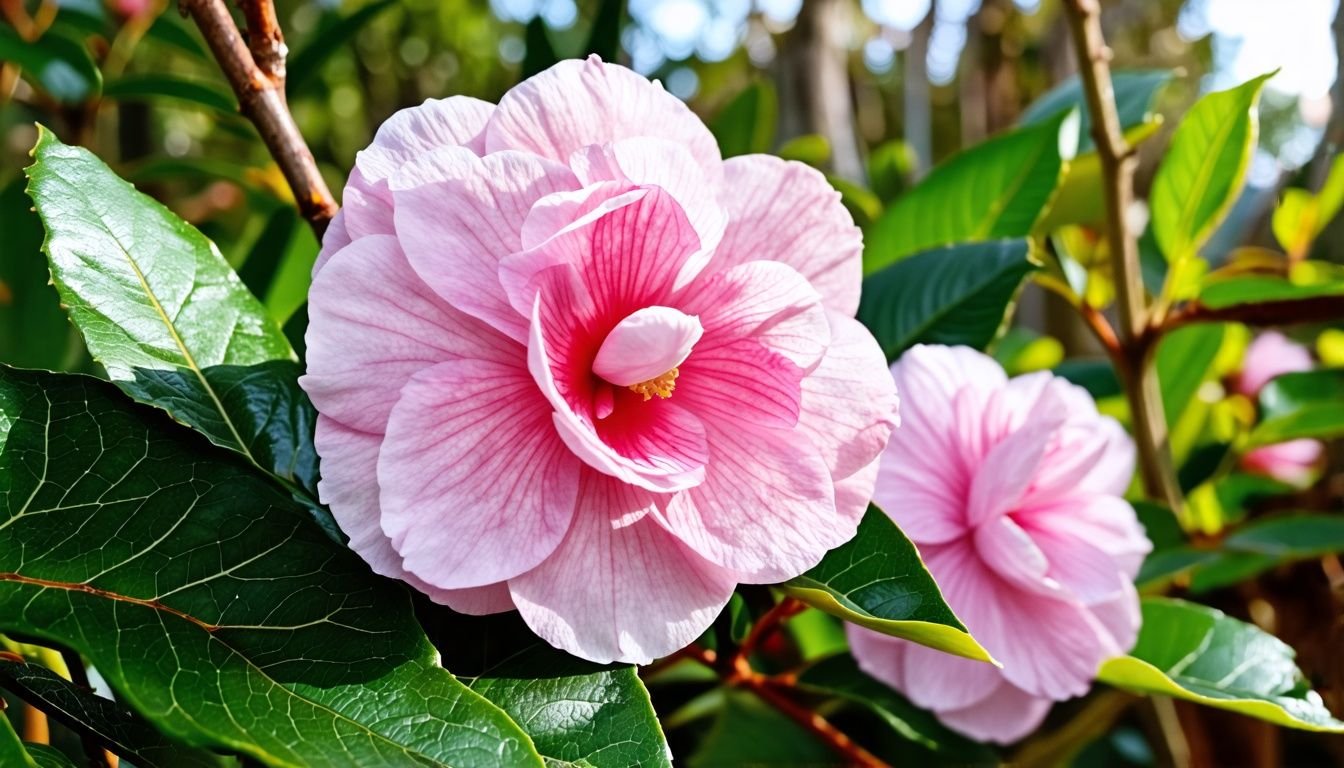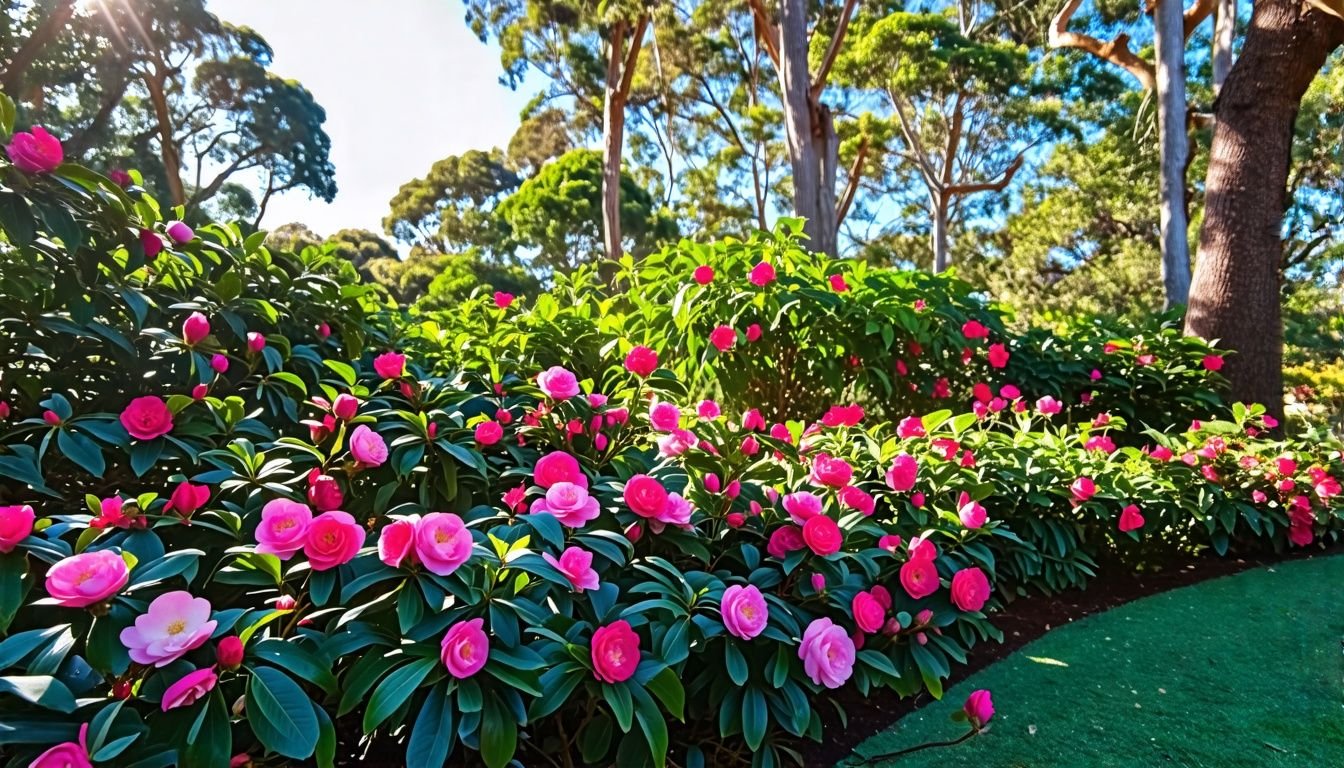G’day, fellow Aussie gardeners! Struggling to grow camellias in those shady spots of your backyard? You’re not alone, mate. We’ve all been there, scratching our heads and wondering if these gorgeous blooms can really thrive without much sunlight.
It’s a fair dinkum worry, especially if you’ve got a garden full of gum trees or other leafy giants blocking out the rays. But here’s the good news: camellias are tougher than they look! Many varieties can actually do quite well in full shade, making them a ripper choice for those dark corners of your garden.
We’ve done our fair share of experimenting in our own patches and picked up some handy tips along the way. From choosing the right types of camellias to getting the soil just right, we’ve got you covered.
So, if you’re keen to add some colour to your shady spots, stick around. We’ll show you how to turn those gloomy areas into a camellia wonderland that’ll have the neighbours green with envy!
Key Takeaways
- Camellias can grow well in full shade in Australia, with varieties like Camellia japonica, sasanqua, reticulata, and sinensis thriving in low-light conditions.
- Shade-grown camellias need acidic soil with a pH between 5.5 and 6.5, and benefit from organic matter like leaf mould or compost to improve soil quality.
- These plants require deep watering once a week during dry spells, and feeding with a balanced, acid-forming fertiliser in spring and autumn.
- Camellias in shade often grow more slowly but develop denser foliage and broader leaves to catch more light, adapting well to their environment.
- With proper care, shade-loving camellias offer year-round interest in Aussie gardens, with their glossy leaves and stunning blooms brightening up even the darkest corners.
Shade Tolerance of Camellias in Australia

Camellias can thrive in full shade in Australia. Many types of camellias, like Camellia japonica and Camellia sasanqua, grow well with little direct sun.
Varieties suited for full shade
We’ve got great news for shade-loving gardeners in Australia. Several camellia varieties thrive in full shade, adding beauty to those dim corners of your yard.
- Camellia japonica: This species is a top pick for shady spots. Its glossy, deep green leaves stay lush all year. The ‘Margaret Davis’ variety boasts large white blooms edged with pale pink.
- Camellia sasanqua: These plants adapt well to shade. They’re perfect for hedges, with ‘Little Liane’ (white flowers) and ‘Paradise Petite’ (pink flowers) growing to about a metre high.
- Camellia reticulata: This type handles shade like a champ. It sports big, showy flowers that brighten up dark areas. The blooms come in white, pink, and red hues.
- Camellia sinensis: Yes, the tea plant grows well in shade too. It’s a fun choice for gardeners who want to try their hand at tea-making.
- Hybrid varieties: Many camellia hybrids do well in full shade. These plants often mix traits from different species, giving you the best of both worlds.
Growth patterns in shaded environments
Camellias show unique growth patterns in shaded spots. These hardy shrubs adapt well to low light, often growing more slowly but with denser foliage. In full shade, camellias tend to stretch towards any available light, which can result in a slightly leggier form.
Yet, this doesn’t harm their overall health or beauty.
Our Australian gardens benefit from camellias’ shade tolerance. They thrive under the canopy of deciduous trees, creating year-round interest with their glossy leaves. In these dim areas, camellias develop broader, flatter leaves to catch more light.
This clever adaptation helps them make the most of limited sunshine.
Shade-grown camellias need less water and are less prone to sunburn. Their flowers often last longer too, protected from harsh rays. For best results, we pair them with other shade-lovers like hellebores and hostas.
Good soil prep is essential – we add organic matter and mulch with wood chips or bark. We’ll now explore the ideal growing conditions for these shade-dwelling beauties.
Optimal Growing Conditions for Shade-Grown Camellias
Shade-grown camellias thrive in specific conditions. We’ll explore the ideal soil, water, and feeding needs for these beautiful plants.
Soil requirements
We love camellias for their stunning blooms, but they need the right soil to thrive. These beauties prefer acidic soil with a pH between 5.5 and 6.5. In Australia, we often find our soils are too alkaline for camellias.
To address this, we mix in organic matter like leaf mould, well-rotted cow manure, or compost. This not only adjusts the pH but also improves drainage and nutrient content.
For potted camellias, we use a special ericaceous potting mix. This blend caters to their specific needs and helps prevent common issues like yellowing leaves. We also add mulch around our camellias to keep the soil moist and cool.
It’s essential to renew this mulch regularly to maintain soil health. Now, we’ll explore how we water and feed these lovely shrubs to keep them happy and blooming.
Watering and feeding practices
Camellias need proper care to thrive in shaded areas. We’ll guide you through the best watering and feeding practices for these beautiful evergreen shrubs.
- Watering routine:
- Water deeply once a week during dry spells
- Increase watering for sun-exposed plants, especially after planting and during flowering
- Potted camellias need more frequent watering than those in the ground
- Soil moisture:
- Keep soil moist but not waterlogged
- Use mulch to retain moisture and suppress weeds
- Check soil moisture regularly by feeling the top 5 cm of soil
- Feeding schedule:
- Apply controlled release fertiliser in spring and autumn
- Use a Camellia-specific fertiliser to prevent bud balling
- Feed potted camellias more often, about every 6-8 weeks during growing season
- Fertiliser type:
- Choose a balanced, acid-forming fertiliser for camellias
- Liquid fertilisers work well for quick nutrient uptake
- Avoid high-nitrogen fertilisers, which can lead to excessive leaf growth
- Pest management:
- Watch for pests like scale insects and spider mites
- Treat with eco-friendly options like Neem oil
- Remove affected parts and dispose of them properly
Proper soil conditions play a crucial role in camellia health. Let’s explore the ideal soil requirements for these shade-loving perennials.
Conclusion
We’ve seen that camellias can indeed thrive in full shade in Australia. These tough plants adapt well to shady spots, making them perfect for darker corners of Aussie gardens. With the right care, including proper soil and watering, shade-loving camellias will reward us with stunning blooms.
We encourage gardeners to explore different camellia varieties suited for shaded areas. These versatile shrubs offer beauty and colour even in the shadiest parts of our outdoor spaces.
FAQs
1. Can camellias thrive in full shade in Australia?
Camellias, especially C. japonica varieties, can tolerate shade but prefer dappled light. Full shade might limit their growth and flowering. For best results, plant them in spots with morning sun and afternoon shade.
2. What soil conditions do camellias need in Australian gardens?
Camellias love acid soil, similar to rhododendrons. They thrive in well-draining, slightly acidic earth. Mulching with organic matter helps maintain soil acidity and moisture. Avoid using alkaline manures, as these can harm the plants.
3. How do I care for camellias to ensure healthy growth?
Regular mulching keeps roots cool and moist. Prune after flowering to maintain shape. Watch for pests like sooty mould, which can be treated with horticultural oils. Feed with acid-loving plant fertilisers to promote lush foliage and abundant floral displays.
4. Are there specific camellia types better suited for Australian conditions?
Japonicas are popular in Australia due to their hardiness and floral beauty. They adapt well to various climates across the country. Some cultivars are more shade-tolerant than others, so research local varieties for the best fit in your garden.
